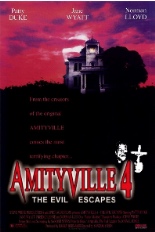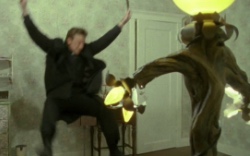
 After Amityville 3-D bombed big at the 1983 box office, the Amityville Horror franchise retreated to network television for the fourth entry, Amityville: The Evil Escapes. Ironically, this first nontheatrical foray at least had the foresight to bring back original screenwriter Sandor Stern, who also stepped into the bound-to-be-thankless job of directing it.
After Amityville 3-D bombed big at the 1983 box office, the Amityville Horror franchise retreated to network television for the fourth entry, Amityville: The Evil Escapes. Ironically, this first nontheatrical foray at least had the foresight to bring back original screenwriter Sandor Stern, who also stepped into the bound-to-be-thankless job of directing it.
Recently widowed, Nancy Evans (Patty Duke, Valley of the Dolls) has no choice but to pack up her three kids and go live with her uptight biddy of a mother, Alice (Jane Wyatt, Star Trek IV: The Voyage Home), in California. Waiting for Nancy at the stately home is a birthday present shipped from her sister, Helen (Peggy McKay, UFOria): one fugly lamp purchased for $100 at a Long Island yard sale as a gag gift. The gag backfires on Helen, who cuts her finger on this gaudy piece of furniture — imagine Sesame Street’s iconic lamppost as constructed by The Wicker Man’s villagers — and gets tetanus and dies, failing to realize she thrifted among the cursed contents at the cursed Amityville house.
 At Alice’s home, the lamp throws everything into disarray. At first, the disturbances are nothing a tube of Neosporin couldn’t solve, then they leap into the sinister with the discovery of Alice’s parrot in the toaster oven (which is probably the title of a Jimmy Buffett song). Other incidents include an out-of-control chainsaw, a sink disposal hand-mauling and strangulation by supernatural extension cord, all culminating in the possession of Nancy’s youngest child (Brandy Gold, Wildcats) and an attic-set showdown pitting a priest (Fredric Lehne, Terror Tract) against, well, the lamp of the damned.
At Alice’s home, the lamp throws everything into disarray. At first, the disturbances are nothing a tube of Neosporin couldn’t solve, then they leap into the sinister with the discovery of Alice’s parrot in the toaster oven (which is probably the title of a Jimmy Buffett song). Other incidents include an out-of-control chainsaw, a sink disposal hand-mauling and strangulation by supernatural extension cord, all culminating in the possession of Nancy’s youngest child (Brandy Gold, Wildcats) and an attic-set showdown pitting a priest (Fredric Lehne, Terror Tract) against, well, the lamp of the damned.
For the virtually bloodless telefilm, Stern brings back several of his 1979 screenplay’s greatest hits: the flies, the red eyes, the sludge, the priest unable to communicate by telephone. Unfortunately, earnest attempts at scares are doomed by mood-killing bright colors, presumably dictated by NBC for prime-time readiness, as Evil Escapes is shot like any of the webs’ disease-of-the-week pics of that era. If made for theaters and aptly cast, with all else being equal, this material could have clicked.
After this, the Amityville sequels were straight to video. Incidentally, the estate sale in the prologue sets up three of them, each following a different object: a clock (Amityville 1992: It’s About Time), a mirror (Amityville: A New Generation) and a dollhouse (uh, Amityville Dollhouse). Producers never got around to all the other items glimpsed, but I’d like to think that an abandoned treatment for The Amityville Thermos sits in a desk somewhere. —Rod Lott
